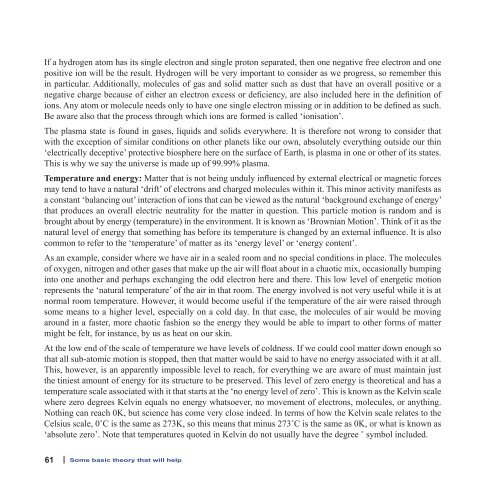A Beginner's View of Our Electric Universe - New
A Beginner's View of Our Electric Universe - New
A Beginner's View of Our Electric Universe - New
You also want an ePaper? Increase the reach of your titles
YUMPU automatically turns print PDFs into web optimized ePapers that Google loves.
If a hydrogen atom has its single electron and single proton separated, then one negative free electron and one<br />
positive ion will be the result. Hydrogen will be very important to consider as we progress, so remember this<br />
in particular. Additionally, molecules <strong>of</strong> gas and solid matter such as dust that have an overall positive or a<br />
negative charge because <strong>of</strong> either an electron excess or deficiency, are also included here in the definition <strong>of</strong><br />
ions. Any atom or molecule needs only to have one single electron missing or in addition to be defined as such.<br />
Be aware also that the process through which ions are formed is called ‘ionisation’.<br />
The plasma state is found in gases, liquids and solids everywhere. It is therefore not wrong to consider that<br />
with the exception <strong>of</strong> similar conditions on other planets like our own, absolutely everything outside our thin<br />
‘electrically deceptive’ protective biosphere here on the surface <strong>of</strong> Earth, is plasma in one or other <strong>of</strong> its states.<br />
This is why we say the universe is made up <strong>of</strong> 99.99% plasma.<br />
Temperature and energy: Matter that is not being unduly influenced by external electrical or magnetic forces<br />
may tend to have a natural ‘drift’ <strong>of</strong> electrons and charged molecules within it. This minor activity manifests as<br />
a constant ‘balancing out’ interaction <strong>of</strong> ions that can be viewed as the natural ‘background exchange <strong>of</strong> energy’<br />
that produces an overall electric neutrality for the matter in question. This particle motion is random and is<br />
brought about by energy (temperature) in the environment. It is known as ‘Brownian Motion’. Think <strong>of</strong> it as the<br />
natural level <strong>of</strong> energy that something has before its temperature is changed by an external influence. It is also<br />
common to refer to the ‘temperature’ <strong>of</strong> matter as its ‘energy level’ or ‘energy content’.<br />
As an example, consider where we have air in a sealed room and no special conditions in place. The molecules<br />
<strong>of</strong> oxygen, nitrogen and other gases that make up the air will float about in a chaotic mix, occasionally bumping<br />
into one another and perhaps exchanging the odd electron here and there. This low level <strong>of</strong> energetic motion<br />
represents the ‘natural temperature’ <strong>of</strong> the air in that room. The energy involved is not very useful while it is at<br />
normal room temperature. However, it would become useful if the temperature <strong>of</strong> the air were raised through<br />
some means to a higher level, especially on a cold day. In that case, the molecules <strong>of</strong> air would be moving<br />
around in a faster, more chaotic fashion so the energy they would be able to impart to other forms <strong>of</strong> matter<br />
might be felt, for instance, by us as heat on our skin.<br />
At the low end <strong>of</strong> the scale <strong>of</strong> temperature we have levels <strong>of</strong> coldness. If we could cool matter down enough so<br />
that all sub-atomic motion is stopped, then that matter would be said to have no energy associated with it at all.<br />
This, however, is an apparently impossible level to reach, for everything we are aware <strong>of</strong> must maintain just<br />
the tiniest amount <strong>of</strong> energy for its structure to be preserved. This level <strong>of</strong> zero energy is theoretical and has a<br />
temperature scale associated with it that starts at the ‘no energy level <strong>of</strong> zero’. This is known as the Kelvin scale<br />
where zero degrees Kelvin equals no energy whatsoever, no movement <strong>of</strong> electrons, molecules, or anything.<br />
Nothing can reach 0K, but science has come very close indeed. In terms <strong>of</strong> how the Kelvin scale relates to the<br />
Celsius scale, 0˚C is the same as 273K, so this means that minus 273˚C is the same as 0K, or what is known as<br />
‘absolute zero’. Note that temperatures quoted in Kelvin do not usually have the degree ˚ symbol included.<br />
61 | Some basic theory that will help


